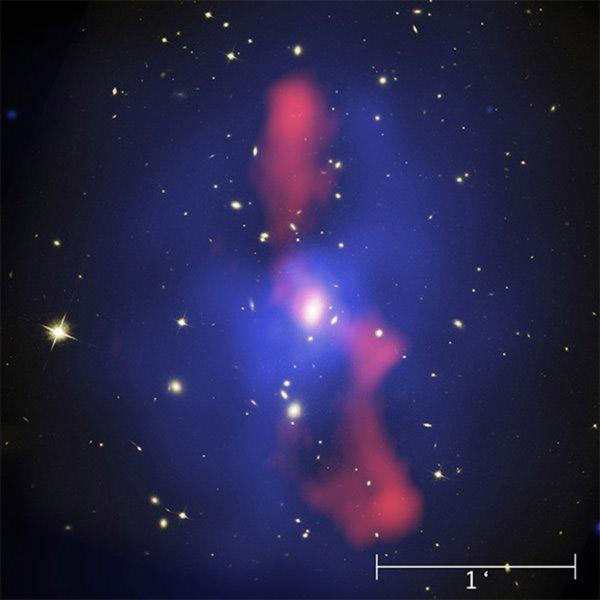
A false color image of the galaxy cluster MS0735.6+7421 showing the effects of the supermassive black hole located at the bright knot at the center of the image. The image combines the X-ray (blue), optical (white), and radio (red) wavelengths. The scale marker corresponds to a distance roughly seven times larger than the diameter of our Milky Way galaxy.
Massive black holes -- ones that contain millions of solar masses of material -- or even supermassive black holes with billions of solar masses, are thought to reside at the centers of most galaxies including our own Milky Way. They help to determine the behavior of galaxies
through their powerful gravitational force, and so they are of fundamental importance. The massive black holes in galactic nuclei often vigorously accrete material in a process that results in the powerful ejection of jets of particles and the stimulation of the environment to radiate brightly at X-ray and other wavelengths. Astronomers, however, do not understand these objects, how they develop, or how they affect the subsequent evolution of a galaxy and its stars.
In clusters of galaxies, supermassive black holes at one of the galaxy nuclei can generate intense shocks, plumes of hot material, and giant cavities in the gas between the galaxies in the cluster. Chandra X-ray Observatory images of the hot gas in galaxy clusters reveals a wealth of these structures, enabling scientists to estimate the stupendous energies involved. In the case of one such cluster, for example, the cumulative energies involved are over a billion times more than all the energy our sun will radiate over its entire lifetime. How are such fantastic energies produced?
CfA astronomers Brian McNamara and Paul Nulsen, together with five colleagues, found a likely answer in the case of one such supermassive black hole whose energies are so dramatic that basic physical constraints could be used to eliminate some options. The scientists argued that there were only two reasonable possibilities. The first entails huge quantities of matter accreting onto the black hole. This is the solution most often invoked for explaining cluster jets, but in this case the process would require about 600 million solar-masses of infall, much more than can be explained without introducing other problems. (A possible way out might exist if the black hole were extremely supermassive with more than ten billion solar masses of material.) The second method involves a rapidly spinning black hole which can release tremendous energies via its magnetic fields without the need for accreting such large amounts of matter. This latter solution also has its problems though: how, exactly, did the black hole acquire its rapid spin, for example? But while puzzling, the features of spin do not violate any basic principles. The new results show that, at least in this object, spin as well as accretion may power the dramatic outbursts from supermassive black holes.